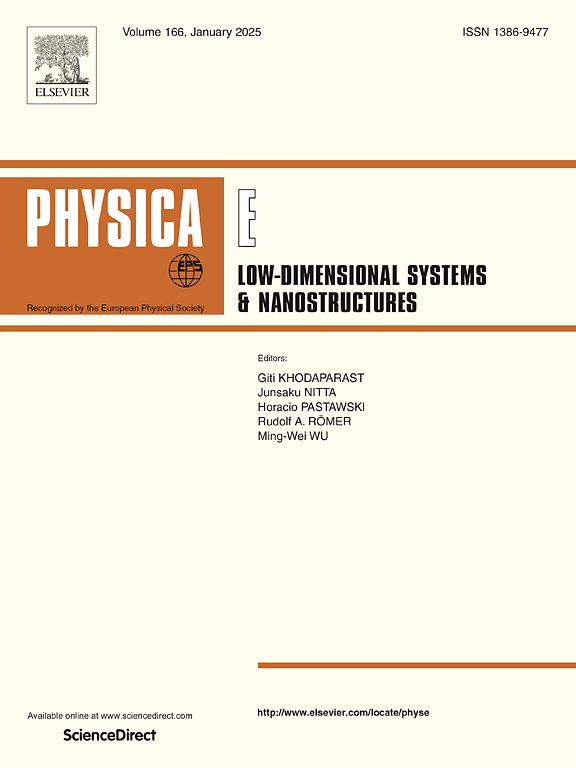Coherent and incoherent phonon transport in graphene/h-BN superlattice: A machine learning potential
IF 2.9
3区 物理与天体物理
Q3 NANOSCIENCE & NANOTECHNOLOGY
Physica E-low-dimensional Systems & Nanostructures
Pub Date : 2025-04-15
DOI:10.1016/j.physe.2025.116259
引用次数: 0
Abstract
Currently, numerous studies demonstrate two mechanisms of coherent and incoherent phonon transport in superlattices. The graphene/hexagonal boron nitride (h-BN) superlattice has attracted significant attention because of its excellent thermal, electrical, and mechanical properties. In this study, we construct an accurate neuroevolution potential (NEP) model and conduct molecular dynamics (MD) simulations using the GPUMD package to investigate phonon transport behavior in the graphene/h-BN superlattice. We find that with increasing periods, phonons transition from coherent to incoherent transport, with their intersection corresponding to the lowest thermal conductivity. Additionally, we discuss phonon transport under varying temperature conditions. We also explore phonon transport in aperiodic superlattices to further illustrate the impact of structural disorder. This study enhances our understanding of phonon transport in superlattices and has the potential to broaden the application of graphene/h-BN superlattices in thermal management and electronic devices.
石墨烯/h-BN超晶格中相干和非相干声子输运:一种机器学习潜力
目前,大量研究证明了超晶格中相干和非相干声子输运的两种机制。石墨烯/六方氮化硼(h-BN)超晶格由于其优异的热学、电学和力学性能而引起了人们的广泛关注。在这项研究中,我们构建了一个精确的神经进化电位(NEP)模型,并使用GPUMD包进行分子动力学(MD)模拟,以研究石墨烯/h-BN超晶格中的声子传输行为。我们发现随着周期的增加,声子从相干输运转变为非相干输运,它们的交点对应于最低的导热系数。此外,我们讨论了不同温度条件下的声子输运。我们还探讨了非周期超晶格中的声子输运,以进一步说明结构无序的影响。该研究增强了我们对超晶格中声子输运的理解,并有可能扩大石墨烯/h-BN超晶格在热管理和电子器件中的应用。
本文章由计算机程序翻译,如有差异,请以英文原文为准。
求助全文
约1分钟内获得全文
求助全文
来源期刊
CiteScore
7.30
自引率
6.10%
发文量
356
审稿时长
65 days
期刊介绍:
Physica E: Low-dimensional systems and nanostructures contains papers and invited review articles on the fundamental and applied aspects of physics in low-dimensional electron systems, in semiconductor heterostructures, oxide interfaces, quantum wells and superlattices, quantum wires and dots, novel quantum states of matter such as topological insulators, and Weyl semimetals.
Both theoretical and experimental contributions are invited. Topics suitable for publication in this journal include spin related phenomena, optical and transport properties, many-body effects, integer and fractional quantum Hall effects, quantum spin Hall effect, single electron effects and devices, Majorana fermions, and other novel phenomena.
Keywords:
• topological insulators/superconductors, majorana fermions, Wyel semimetals;
• quantum and neuromorphic computing/quantum information physics and devices based on low dimensional systems;
• layered superconductivity, low dimensional systems with superconducting proximity effect;
• 2D materials such as transition metal dichalcogenides;
• oxide heterostructures including ZnO, SrTiO3 etc;
• carbon nanostructures (graphene, carbon nanotubes, diamond NV center, etc.)
• quantum wells and superlattices;
• quantum Hall effect, quantum spin Hall effect, quantum anomalous Hall effect;
• optical- and phonons-related phenomena;
• magnetic-semiconductor structures;
• charge/spin-, magnon-, skyrmion-, Cooper pair- and majorana fermion- transport and tunneling;
• ultra-fast nonlinear optical phenomena;
• novel devices and applications (such as high performance sensor, solar cell, etc);
• novel growth and fabrication techniques for nanostructures

 求助内容:
求助内容: 应助结果提醒方式:
应助结果提醒方式:


